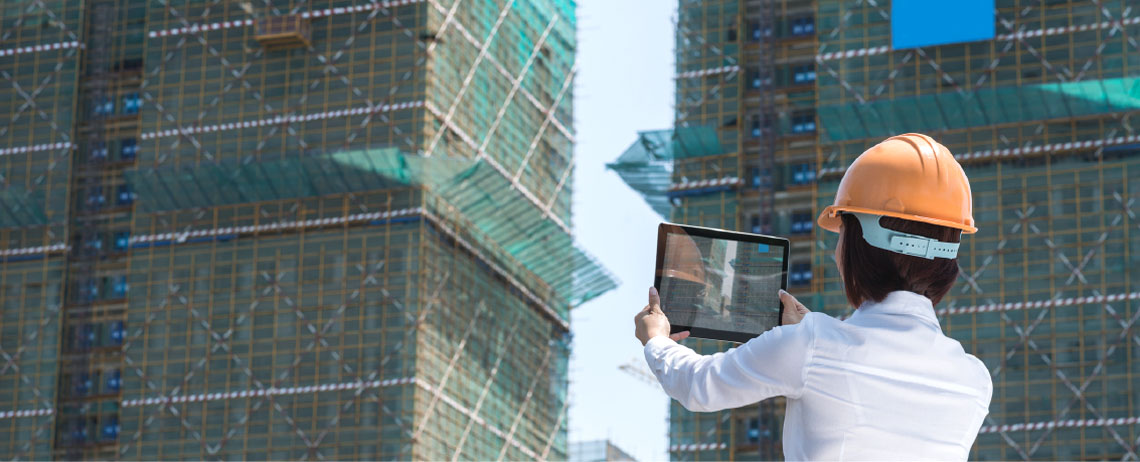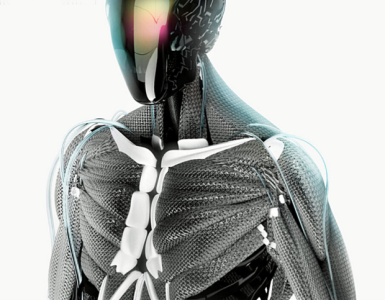Jason is a contractor, working a high-rise construction site in lower Manhattan. He stands up from the kitchen table, readying himself for another day on the job. He raises his hard hat to his head, adjusting its molded plastic visor to sit squarely across his vision.
“Power on,” he says, taking one final bite of his breakfast bagel. “Download today’s construction plans, Building C, Floors 68 through 74.”
He holds his hand out, contorting his fingers like a puppet master. He moves his palm back and forth from his periphery to the center of his vision and walks through each drawing.
Jason is setting up the day’s virtual toolbox. His hard hat is not a typical plastic OSHA requirement. It’s a virtual and augmented reality helmet and an essential device for his career.
Unlike typical construction headwear, virtual and augmented realities through this helmet ensures Jason and his colleagues can walk safely through a building under construction, make virtual changes in this environment and get everything working perfectly before making real life constructions. This could be the future of BIM (Building Information Model) and all land development sites—a future influenced by augmented reality.
VR vs. AR:
Both virtual reality (VR) and augmented reality (AR) offer users the ability to interact with their environment.
VR is a fully artificial surrounding, the illusion of reality. Users see and work with a three-dimensional imaginary environment, like a simulation machine. VR can be experienced through devices such as headsets, omni-directional treadmills, and specialized gloves.
On the other hand, AR takes a view of the real world and augments it with an additional computer-generated environment providing an “upgraded” view of the physical world. It essentially overlays graphics on top of an existing target. For the purpose of this article, the focus will be AR.
The current state of things:
One of the largest investments in AR is occurring in the retail industry. Retailers are scrambling to include augmented reality in their shopping experiences; AR gives them an edge over the competition, allowing potential customers to experience products before making a purchase. For instance American Apparel is allowing customers to “wear” clothing—overlaying their products on virtual avatars so shoppers can visualize what the style looks like on them.
AR is not just limited to clothing. Shoe stores such as Converse created a mobile AR app so customers can try on their shoes. Ikea created their own app to allow shoppers to place furniture within their homes and check for fit, color, and size. Shoppers can also sample paint colors for walls, virtually apply cosmetics, or try on luxury jewelry.
Augmented reality technology and use has already gone mainstream, albeit on a low-level scale. Various popular Snapchat filters employ some form of augmentation. Recently, the company has even announced larger scale AR experiences at Disneyland and Universal Studios. New advancements in “wearables”, such as HTC’s Vive Pro, allow for better wireless AR experiences.
And things aren’t stopping there. With the ARCore from Google, augmented reality applications can now be built easily for Android devices. For iOS users, Apple has released the ARKit2 for the development of mobile applications for their platform.
The near future:
While some still believe augmented reality is only for developing games that keep players immersed (i.e. 2016’s Pokémon Go craze), the technology has great potential across the economic frontier. According to Lumus, an Israeli-based Augmented Reality company, AR is projected to generate revenue as high as $2.6 billion and $4.1 billion in just the real estate and medicine industries by the year 2025. The AR market could be worth as much as $162 billion, according to the BBC.
Augmented reality could bring about a future where sellers could display their products just about anywhere, without the need for a huge physical store. Through augmented e-commerce, consumers can try out products, getting a virtual feel for them before purchasing them.
The future of digital marketing and advertising could benefit massively from augmented reality, as targeted customers can be exposed to “real” advertisements. This could increase the conversion rates for digital marketers, as sellers are more likely to purchase products with an increase in exposure to interactive advertisements.
The drawbacks:
It’s possible for someone to walk around an urban downtown with their AR headsets active, deleting scenes they don’t want to see. Imagine thinking away homeless people on the street or erasing trash and plastics along a beach front and creating a personalized utopia. The restructured reality could become a weapon for spreading apathy and indifference, working against environmental and societal concerns.
Other mental and psychological concerns include addiction and over-dependency on AR technology. A person could such a dopamine junkie, their sleep cycles will be altered and their bodies will be more susceptible to fatigue.
Physical hazards could include eye strain and hearing loss from increased headset usage. Dizziness, disorientation, or confusion could occur if a user were too immersed in the AR. Injuries—or worse, death—have been documented with games such as Pokemon Go and this could increase as the technology spreads.
Privacy and security concerns are always a possibility with any technology, augmented reality being no different. Imagine what would happen if a person accidentally installs malware that piggybacked onto a popular AR app and they are using the app in an urban environment. What would stop the malware from deleting oncoming traffic or convincing a user it was safe to cross a pedestrian crosswalk? What other malicious intents could occur?
The possibilities ahead:
AR technology continues to expand with almost a limitless line of sight and possibilities. And, while it’s been embraced through gaming and retail areas, it will easily branch into other fields such as education, training, aviation, and health services.
Imagine an open-heart surgery where the patient’s anatomy is augmented to warn of any impending issues or dangers, where his or her next tool is listed, where appropriate medicines are suggested, and where the patient’s vitals are displayed clearly in his vision. Efficiency, safety, and reliability would all be improved.
An aircraft mechanic will be able work on the critical components of an engine, each critical step listed, every part and loose bolt highlighted, and every tool accounted for. Any misstep and his eyes flash with warnings. Considering that maintenance errors contributed to 42% of fatal airline accidents in the US from 1994-2004, AR improvements could bring about a massive reduction in the loss of lives.
The military, and even policing, could be improved. AR could visually assist policemen to inform them of whether or not a suspect was armed, greatly reducing the amount of erroneous police shootings. Some departments are already using police AR technology for training patrol officers, SWAT teams, and crime scene investigators.
For STEM students, experiments, practice, and repairs can be possible without putting funds or lives on the line. Students would no longer be exposed to toxic lab environments or situations. Marine biology students could use the HTC Vive headset and study the effects of carbon dioxide on marine life. Structural engineers could study tensive and compressive strengths of various materials. Virtual field trips could be taken around the world and help students monitor environmental effects.
Augmented reality has no lack of possibility. It’s breadth is as limited as the imagination. Through this technology, the world of the future would find their experiences more enriching than ever before.






Add comment